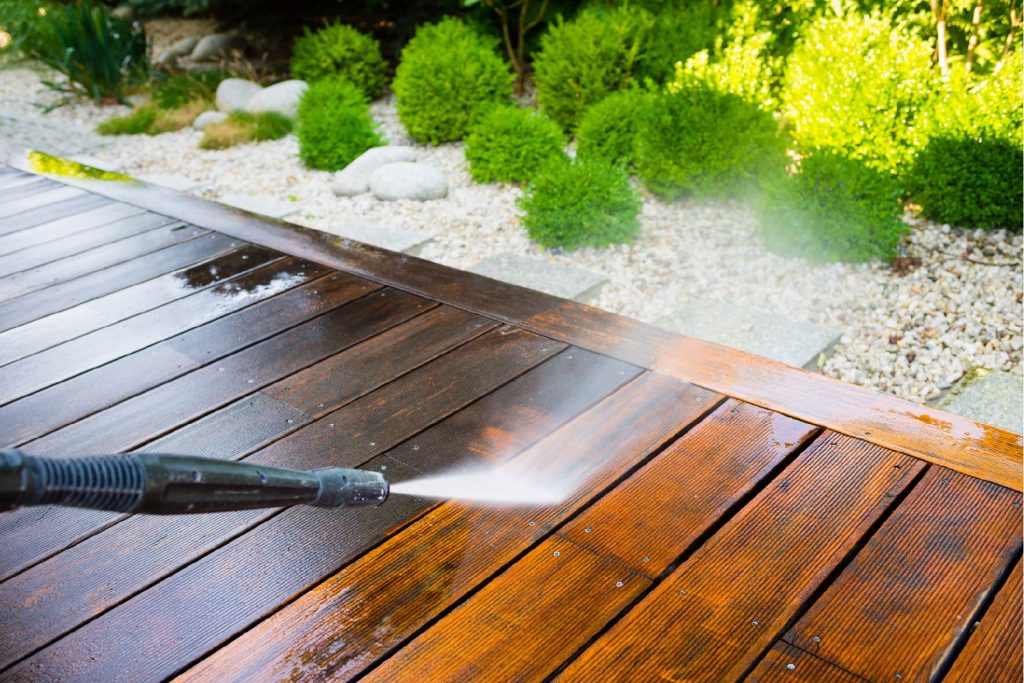Deck Cleaning and Maintenance Tips

1. Please provide step by step instructions on how to clean and revive outdoor decking. Where should you start? How should you prep (ie sweep and remove dirt, cobwebs and leaves)?
1. Sweep away dust, cobwebs, leaves and bird droppings.
2. Using a hard-bristle brush, scrub the deck with a mild detergent solution to remove embedded dirt, grease and grime. Rinse with fresh water.
3. Once the deck is completely dry, apply two to three coats of the timber coating last used on the deck.
If the deck is in bad condition, it may be necessary to strip back and sand the surface before recoating. Signs a deck may need to be recoated include peeling, flaking, discolouration, mould growth or greying of the timber surface.
Any areas affected by mould or mildew must be properly treated before recoating, otherwise, mould will continue to grow underneath the fresh paintwork.
2. Which cleaning tools and products should you use?
A pressure washer is ideal for cleaning hardwood decks such as ironbark, Merbau and blackbutt (pressure washers are not recommended for use on softwood). Otherwise, a good hard-bristle brush works well to remove stubborn dirt and grime.
When coating a freshly cleaned deck, use a pure-bristle brush for a smooth, even finish. Applicator pads and paint rollers are not ideal for coating timber as they can apply product unevenly. Additionally, rollers can aerate the timber coating causing air bubbles that will leave ‘pock-marks’ once the coating has cured.
3. Are there any tools or products to avoid (ie pressure cleaners)? How can these damage decking?
While pressure washers are ideal for use on hardwood decks, they should not be used on softwoods such as treated pine or western red cedar. The high-pressure jet stream can leave impressions in the soft timber.
Do not use steel wool to scrub timber decks. Steel wool reacts with timber leaving black marks on the surface.
Do not use heavy acids on timber surfaces. These can discolour or etch the surface of the decking.
4. How can you remove stubborn stains and marks?
Using a cloth or sponge, apply an oxalic acids based cleaner such as Sikkens Cetol BL® Deck & Wood Cleaner to the mark or stain. Leave for about 15 minutes before washing away with fresh water.
If the stain does not come away easily, then it may be necessary to sand and recoat the entire deck.
5. Is the cleaning routine the same for all main outdoor decking types? If it differs, how?
Generally, the cleaning process is the same for all main timber species.
The primary difference is between new and existing decks. New hardwood decks require an application of Sikkens Cetol BL Tannin remover to assist with extracting the naturally occurring tannin within the timbre fibres prior to coating. Existing decks that are in relatively good condition only require washing with a mild detergent solution before recoating.
6. Should you nourish and seal your deck after cleaning? If yes, how?
Timber is a porous material and should always be coated after cleaning to protect the surface from dirt, grime, UV damage and moisture. A good quality coating such as Sikkens Cetol HLSe will keep the deck looking its best for longer, minimising future maintenance.
7. We’d like to include one or two tips for tools or products you would highly recommend to clean or revive outdoor decking – what would they be, please?
- Whether oil or water-based, always choose the best timber coating you can afford. Quality coatings may be more expensive but will last much longer (up to two years) than cheap decking oils, which may need to be applied every few months to keep the deck looking its best.
- A pressure washer is ideal for hardwood decks; otherwise, a good hard-bristle brush is ideal for scrubbing timber boards.
- The Sikkens Ezee Deck Brush is an ideal tool for applying timber coatings. The soft pure-bristle brush ensures coatings are worked evenly into the grain of the timber, while a long broom-like handle prevents the need to get down on hands and knees.